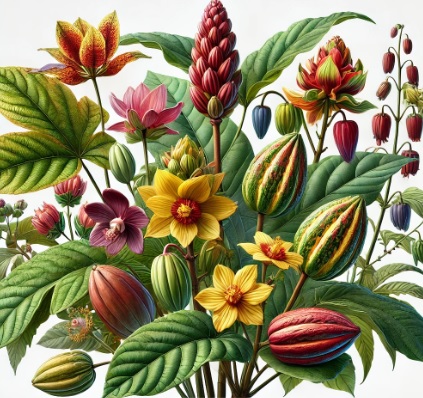The Sterculiaceae family is a group of plants belonging to the order Malvales, comprising about 20 genera and over 200 species. These plants are mostly tropical trees and shrubs, predominantly distributed in tropical and subtropical regions around the world. Some species in this family are of economic interest for their edible fruits, oil, and fibers. Notable members of this family include Sterculia, Theobroma (the cacao genus), and Hibiscus (which includes ornamental and medicinal plants).
General Description
Plants in the Sterculiaceae family are typically trees or shrubs with some common characteristics:
- Leaves: The leaves are generally large, alternate, and often palmately or lobed. In many species, the leaves have a prominent midrib.
- Flowers: The flowers of Sterculiaceae plants are usually large, with fleshy and often colorful petals. They can be unisexual or bisexual, and many species have fragrant flowers. These flowers are pollinator-attractive, attracting insects such as bees and butterflies.
- Fruits: The fruits are often capsules or berries containing seeds. In some species, the fruits are edible, such as in Theobroma cacao (cacao), while in others, they are used for producing fibers or oils.
- Roots and Bark: The bark of many species is thick and sometimes rich in resin, which can be used in various ways. The roots may be shallow or deeply developed, adapted to tropical and subtropical environments.
Chemical Composition
Plants in the Sterculiaceae family contain a variety of bioactive compounds that make them useful in medicine, cuisine, and industry:
- Vegetable Oils: Many plants in the family, such as Sterculia and Theobroma, produce vegetable oils. Sterculia oil is known for its emollient properties and is used in cosmetics and pharmaceuticals.
- Alkaloids: Theobroma cacao contains alkaloids like theobromine, which is a natural vasodilator and has stimulating effects on the central nervous system. Theobromine is also present in other species in the family.
- Flavonoids: Plants in the Sterculiaceae family contain flavonoids, known for their antioxidant, anti-inflammatory, and anticancer properties.
- Polyphenols: Cacao, in particular, is rich in polyphenols, which are known for their cardiovascular benefits and antioxidant effects.
Physical Properties
- Size: Plants in the Sterculiaceae family vary in size from small shrubs to large trees that can exceed 30 meters in height in some tropical species.
- Wood and Fiber: The wood of some species, such as those in the Sterculia genus, is hard and durable, but it can also be used for fiber production. The bark of some species produces fibers used for industrial purposes, such as ropes and textiles.
- Fruits: Fruits in the family come in different shapes, often having a fleshy consistency and containing seeds. The cacao fruit, for example, is a capsule that contains the seeds (cacao beans), from which chocolate is made.
Production and Harvesting
Some members of the Sterculiaceae family are cultivated for their fruits and oils:
- Cacao (Theobroma cacao): The most well-known species in the family, cacao, is the primary source of chocolate. The cacao beans are extracted from the fruit and processed into cacao powder and cacao butter, which are used in chocolate and other food products.
- Sterculia: Some species of Sterculia are cultivated for their oil, which is extracted from the seeds and used in cosmetics and pharmaceuticals for its emollient and healing properties.
- Hibiscus (Hibiscus rosa-sinensis): Hibiscus is widely cultivated as an ornamental plant and for its flowers, which are used to make tea and infusions.
Applications
Medicinal
Plants in the Sterculiaceae family are used in traditional medicine for a variety of treatments:
- Cacao (Theobroma cacao): Cacao is known for its cardiovascular benefits, thanks to the flavonoids and theobromine. It is also used to improve mood and reduce stress. Additionally, the polyphenols in cacao have antioxidant properties that help protect the body from free radical damage.
- Sterculia (Sterculia spp.): Sterculia oil is used to treat skin conditions such as irritation and dryness and is also used in some pharmaceutical preparations for its soothing and healing effects.
- Hibiscus (Hibiscus rosa-sinensis): Hibiscus tea is known for its ability to lower blood pressure and for its high vitamin C content, which helps boost the immune system.
Cosmetics
Plants in the Sterculiaceae family are widely used in the cosmetic industry:
- Cacao (Theobroma cacao): Cacao butter is a popular ingredient in skincare products due to its moisturizing and nourishing properties. It is commonly used in creams, lotions, and lip balms.
- Sterculia (Sterculia spp.): Sterculia oil is used in creams and lotions for its emollient properties, helping to keep the skin soft and hydrated.
Environmental
Plants in the Sterculiaceae family also contribute to the environment:
- Biodiversity: Plants like Hibiscus and Sterculia are important for biodiversity in their natural habitats, where they provide food and shelter for various species of insects, birds, and other animals.
- Carbon Sequestration: Trees of the Sterculiaceae family, such as Sterculia species, are high carbon-sequestering plants and play a role in local climate regulation in tropical rainforests.
Environmental and Safety Considerations
While plants in the Sterculiaceae family offer many benefits, there are some considerations to keep in mind:
- Sustainability: The harvesting of Theobroma cacao is a major agricultural activity in some tropical regions. It is important to adopt sustainable farming practices to avoid deforestation and environmental degradation in cacao-growing areas.
- Safety: While plants in the Sterculiaceae family are generally safe, some species may cause allergic reactions in certain individuals, especially with extracts from flowers or resins.
INCI Functions
- Antioxidant: Protects the skin from oxidative damage.
- Moisturizing: Helps to maintain moisture in the skin.
- Anti-inflammatory: Reduces inflammation and soothes irritated skin.
Conclusion
The Sterculiaceae family is a group of tropical plants with numerous commercial, medicinal, and cosmetic applications. Cacao, Sterculia, and Hibiscus are just a few important plants in this family. Thanks to their nutritional, therapeutic, and cosmetic benefits, these plants continue to be valuable resources for human health and well-being.
![]() Sterculiaceae
Sterculiaceae 

